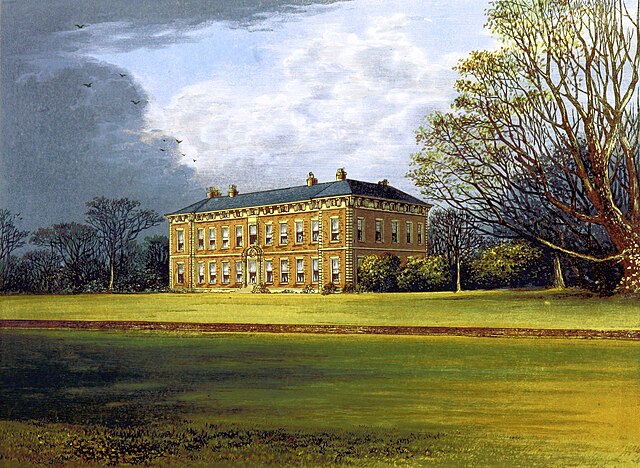Beningbrough Hall
Listed building in North Yorkshire, England From Wikipedia, the free encyclopedia
Beningbrough Hall is a large Baroque[1][2] mansion near the village of Beningbrough, North Yorkshire, England, and overlooks the River Ouse.
| Beningbrough Hall | |
|---|---|
 Front facade of Beningbrough Hall | |
| Type | Country house |
| Location | Beningbrough, North Yorkshire |
| Coordinates | 54.02070°N 1.21060°W |
| Built | 1716 |
| Built for | John Bourchier III |
| Original use | Private home |
| Current use | Museum |
| Architect | William Thornton |
| Architectural style(s) | Baroque |
| Owner | National Trust |
| Website | nationaltrust.org.uk/beningbrough-hall-gallery-and-gardens |
Listed Building – Grade I | |
| Official name | Beningbrough Hall |
| Designated | 28 February 1952 |
| Reference no. | 1150998 |
| Official name | Beningbrough Hall |
| Designated | 10 May 1984 |
| Reference no. | 1001057 |
It has baroque interiors, cantilevered stairs, wood carving and central corridors which run the length of the house. Externally the house is a red-brick Baroque mansion with a grand drive running to the main frontage and a walled garden, The house is home to changing exhibitions on the first floor art gallery and stories of the estate on the ground floor. It has a restaurant, shop and garden shop, and was shortlisted in 2010 for the Guardian Family Friendly Museum Award.
The Hall is set in extensive grounds and is separated from them by a ha-ha (a sunken wall)[3] to prevent sheep and cattle entering the Hall's gardens or the Hall itself. The gardens are undergoing a redesign by garden designer Andy Sturgeon.
History
Summarize
Perspective
Beningbrough Hall, situated 6.2 miles (10 km)[4] north-west of York, was built in 1716 by a York landowner, John Bourchier III[5] to replace his family's modest Elizabethan manor, which had been built in 1556 by Sir Ralph Bourchier on his inheritance to the estate.[6] Local builder William Thornton oversaw the construction, but Beningbrough's designer remains a mystery; possibly it was Thomas Archer.[7] Bourchier was High Sheriff of Yorkshire for 1719–1721 and died in 1736 at the age of 52.[8]

John Bourchier (1710–1759) followed his father as owner of Beningbrough Hall and was High Sheriff in 1749. It then passed to Dr. Ralph Bourchier, a 71-year-old physician and from him to his daughter, Margaret, who lived there for 70 years. Today a Bourchier knot is cut into a lawn adjoining the house.[9]
After over 100 years in the Bourchiers' possession, the estate passed in 1827 to the Rev. William Henry Dawnay, the future 6th Viscount Downe, a distant relative.[5] He died in 1846 and left the house to his second son, Payan, who was High Sheriff for 1851.[10] The house was neglected, prompting fears that it might have to be demolished. In 1916, however, a wealthy heiress, Enid Scudamore-Stanhope, Countess of Chesterfield, bought it and immediately set about its restoration, filling it with furnishings and paintings from her ancestral home, Holme Lacy in Herefordshire.[8]

During the Second World War the hall was occupied by the Royal Air Force then latterly, the Royal Canadian Air Force, when under No. 6 Group of Bomber Command, they took over some of the bases in the region (such as the nearby RAF Linton-on-Ouse and RAF Leeming).[11]
Lady Chesterfield died in 1957, and in June 1958 the estate was acquired by the National Trust after it had been accepted by the government in lieu of death duties at a cost of £29,250.[12] In partnership with the National Portrait Gallery the hall exhibits more than a hundred 18th-century portraits[13] and has seven new interpretation galleries called 'Making Faces: 18th-century Style'. Outside the main building there is a Victorian laundry and a walled garden with fruit and vegetable planting, the produce from which is used by the walled garden restaurant.[14]
Beningbrough Hall includes a wilderness play area, community orchard, an Italianate border and garden shop. It hosts events, activity days, family art workshops,[15] and an annual food and craft festival which in 2010 was a Big Green Festival.[16]

See also
- Grade I listed buildings in North Yorkshire (district)
- Listed buildings in Beningbrough
- Bourchier knot, a heraldic representation of the Granny knot or Reef knot used by the Bourchier family.
References
Further reading
External links
Wikiwand - on
Seamless Wikipedia browsing. On steroids.

